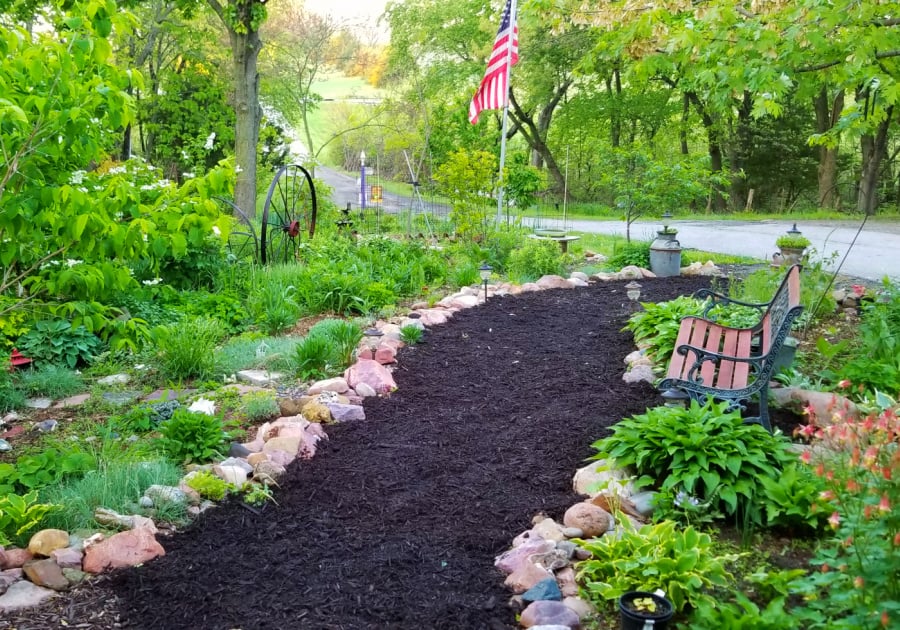Edging for the garden may not sound like an important issue, but it should be thought of. One of the lesser parts of the landscape, edging is the part which defines it the best. And it plays an important role it separating the spaces of the garden. Over the years I have seen many things in the landscape. And the one thing that really helps a landscape maintain its independence from the lawn, is the edging.
There are many different types of edging. One can use plants, wood, metal, stone, plastic, concrete, or a natural edge. But you do need something if you are going have lawn bump up against your planting beds. Each type of edging has its own benefits and concerns. However, there is one which stands out above the others, and which I will go into more detail about. That is concrete edging.
Concrete Edging
While I personally do not have this at my own house, I wish I did. Concrete edging is easier to maintain and install than almost any other type of edging. And it is certainly more appealing than most. Of course, you need to match your edging (if possible) to your home and landscape. Because we can stamp patterns and use colors in concrete edging, we can match it to almost any style of home or landscape.
The only detriment to concrete edging that is really noticeable, is the price. But if you are already installing a $4000 landscape, would it not be better to have edging that compliments it, not takes away from it? Concrete edging must be done by professionals yes, but so must other forms of edging to get them looking just right. So upgrade to concrete edging, if you are already spending a lot on the landscape.

Metal Edging Products
There are a variety of metal edging products available, from steel to aluminum. I have even known people to use copper plates (squares) linked up as edging. If you want to go the cheaper, but durable way of edging, go with steel. Steel is tough, it will last for a couple of decades of use, before needing replaced. However, it can be difficult to get in the ground correctly, and it does not work when there are hills or rises in the ground in the landscape.
Another problem I have with steel edging, is that it pops up our of the ground when you have frost heaving.
What is frost heaving? An upward swelling of soil during freezing conditions caused by an increasing presence of ice as it grows towards the surface, upwards from the depth in the soil where freezing temperatures have penetrated into the soil (the freezing front or freezing boundary).

Stone
I myself use fieldstones to line the edges of most of my garden beds. The ones that do not have it, have either a natural edge or plants as the edge. I started using fieldstones some 15 years ago and now I do not know what I would do if I changed styles. I have so many rocks. And one of the things we love to do as a family is go rock hunting for more.
Stones used for edging can be cut or left natural. I have put in cut stone edging and you must put an underlayment of sand below, and be very precise when laying in the stone. I prefer the fieldstone method, as it looks more natural, even if some of the rocks come from far away. But it is difficult to mow and trim around fieldstones, there are a lot of cracks and crevices. And kids like to move them too.

Other Edging Materials
I have rarely seen edges look good when using plastic, wood, or other materials. A few exceptions include using logs cut at differing lengths and placed vertically, and one person’s use of china plates. But I do not recall ever having seen plastic edging, be it rolled or plated, looking good. Plastic looks cheap to me. And it is easily damaged by mowers, edgers, and equipment.
Wood, if treated and put in tightly, with logs vertical and not horizontal, can be attractive. But it would be time consuming to install, and most landscape contractors will not do it. I know of a couple of landscapes locally which used “landscape timbers” horizontally as edging. It has fallen apart and become a tripping hazard, and it just does not fit with the landscape style.
In nearly every gardening magazine, especially those like Junk Gardening, or similar, there are examples of found or recycled items being used for edging. In some cases, as with china plates, it is both functional and pretty. However, if your use a brittle material such as china, you would be wise to keep a gravel mowing strip between, so you do not bump into it. Other things, like bowling balls and ninepins, really is impractical, and harder to maintain than my fieldstones.

The Purpose of Maintaining an Edge
But why do we need edging at all? There are 2 main reasons for maintaining an edge between landscape and lawn/path. The first is to keep the landscape mulch in the bed. Over time, as a landscape becomes more mature, a layer of organic matter begins to build up, making the bed higher the surrounding area/lawn. If an edge is not maintained, then mulch and soil can begin to intermingle with the lawn or adjoining paths.
The second reason to maintain an edge, is to keep back turfgrass. Most lawn grasses and plants (clover in some lawns) grows by rhizomes and runners, and will cross over into the organic matter of the landscape bed it allowed. I spend countless hours every year diffing out soil and turf from inside steel edging which has overgrown because the homeowner does not maintain their edge.
The best material for keeping the edge cleaner longer even without proper trimming, is concrete. The worst is wood and plastic.

Conclusion
An edge is needed not only to maintain a clean dividing line between landscape and lawn (or paths), but also to keep back the invading turf or the spilling of the mulch. Do the best you can for your landscape and put in long lasting concrete edging, and let your landscape be the star of the neighborhood.
Happy planting!




